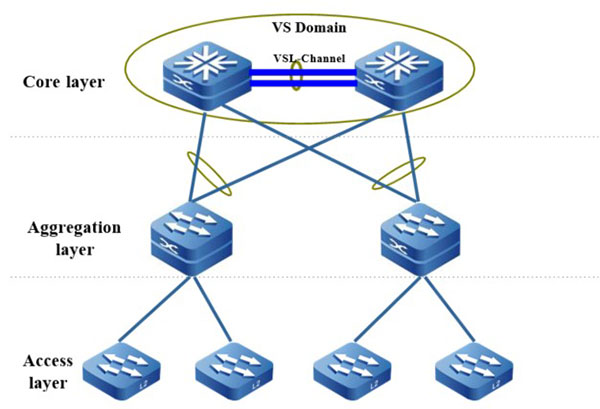With the increasing requirement of the user for reducing the cost and improving the device reliability, Maipu puts forward one technology of combining multiple physical switches to form one virtual switch, that is Virtual Switching Technology, called VST.

Figure 1-1 VST physical network view
As shown in figure 1-1, two devices of the core layer are connected via the VSL interface, forming one VS Domain (virtual switching domain, also called stacking system). The aggregation layer device is uplinked to VS Domain via the link aggregation. The VS Domain of the core layer is one virtual device for the other network devices.
Compared with the traditional L2 spanning tree and L3 VRRP/VBRP technology, the VST had the following advantages:
- The bandwidth increases multiplicatively and is used effectively
Because the traditional technology runs STP/RSTP/MSTP, one of the previous two uplink links is in the forwarding state and the other is in the standby state. After using the VST, multiple devices become one logical device, so do not need to block some links. Two links form one aggregation group and both can be used to forward data, so as to make use of the bandwidth of the links efficiently, avoiding the waste of the bandwidth resources. Besides, the cross-device and cross-board aggregation link can provide the redundant links and also can realize the dynamic load balance, making use of all bandwidths efficiently.
The virtual switching system is formed by multiple member devices. The control device is responsible for the operation, management, and maintenance of the whole virtual switching system and the other member devices are in the standby sate. Once the control device fails and does not rely on the convergence of STP/RSTP/MSTP, VRRP/VBRP, the system elects one new control device from the standby member devices, ensuring that the services of the virtual switching system are not interrupted and improving the reliability when the member device fails.
- Simplify network topology
The virtual device formed by the VST is equivalent to one device in the network, connected with the around devices via the aggregation link. There is no L2 loop, so it is not necessary to configure the STP/RSTP/MSTP protocol. The control layer protocols run on one virtual device, reducing the exchanging of lots of protocol packets between devices and shortening the route convergence time.
After two or more devices form the stacking system, the control platform of the member devices in the virtual switching system are in the standby state, but the data platform is active. The user can log into the virtual switching system via the port of any member device and manages the whole virtual device in a unified manner, but does not need to connect to each member device for management.
 Switch
Switch Wifi - Access Point
Wifi - Access Point Firewall
Firewall Router
Router Module Quang
Module Quang![Module Quang Cisco]() Module Quang Cisco
Module Quang Cisco![Module quang HPE]() Module quang HPE
Module quang HPE![Module quang Maipu]() Module quang Maipu
Module quang Maipu![Module quang Brocade]() Module quang Brocade
Module quang Brocade![Module quang Fortinet]() Module quang Fortinet
Module quang Fortinet![Module quang Aruba]() Module quang Aruba
Module quang Aruba![Module quang OEM]() Module quang OEM
Module quang OEM![Module quang Juniper]() Module quang Juniper
Module quang Juniper![Module quang Dell]() Module quang Dell
Module quang Dell![Module quang Palo Alto]() Module quang Palo Alto
Module quang Palo Alto![Module quang Huawei]() Module quang Huawei
Module quang Huawei![Module quang Arista]() Module quang Arista
Module quang Arista![Module quang F5]() Module quang F5
Module quang F5![Module quang H3C]() Module quang H3C
Module quang H3C![Module Quang Allied Telesis]() Module Quang Allied Telesis
Module Quang Allied Telesis![Module quang SonicWall]() Module quang SonicWall
Module quang SonicWall![Module quang Mikrotik]() Module quang Mikrotik
Module quang Mikrotik![Module quang Handar]() Module quang Handar
Module quang Handar Máy chủ (Server)
Máy chủ (Server) Thiết bị lưu trữ (SAN, NAS)
Thiết bị lưu trữ (SAN, NAS) Load Balancing
Load Balancing Video Conferencing
Video Conferencing Phụ kiện máy chủ
Phụ kiện máy chủ Thiết Bị IoT
Thiết Bị IoT Phụ Kiện Mạng
Phụ Kiện Mạng




.png)
























